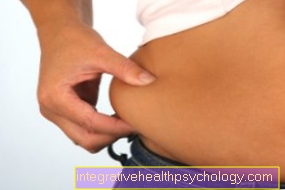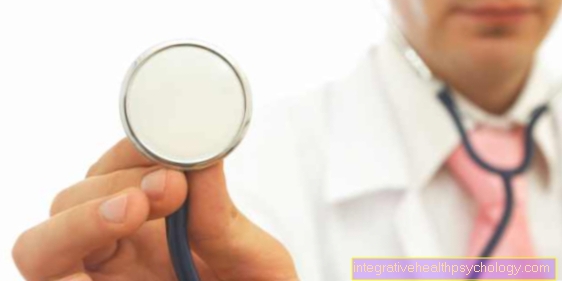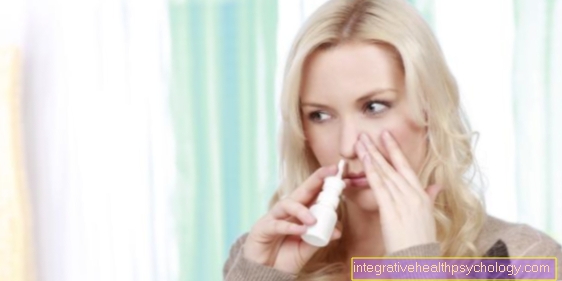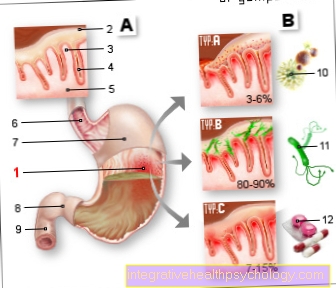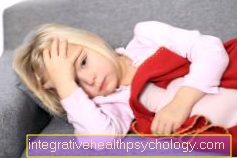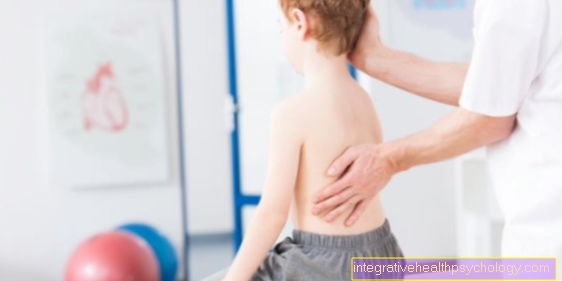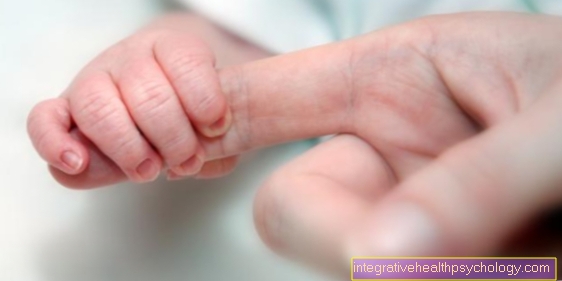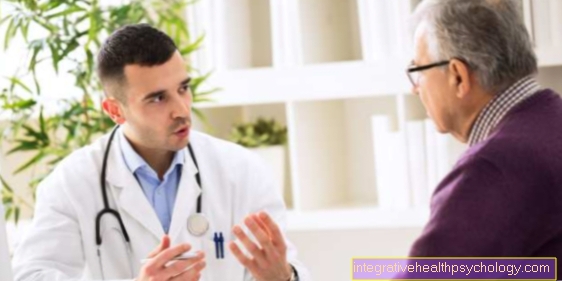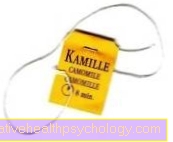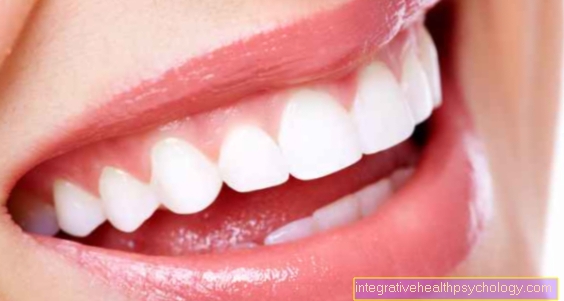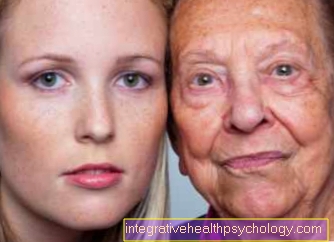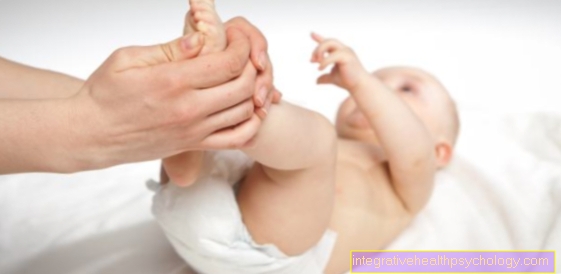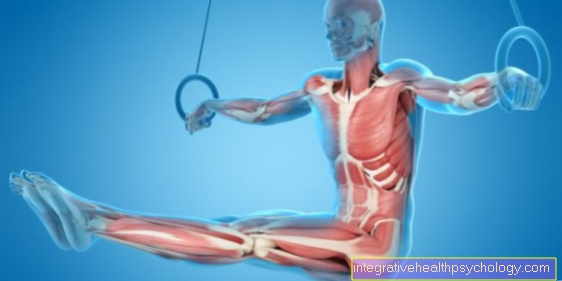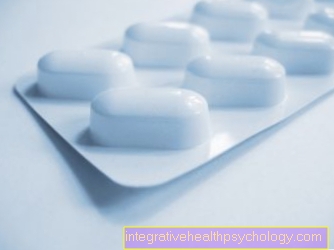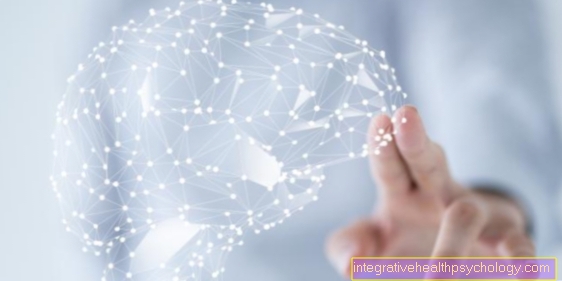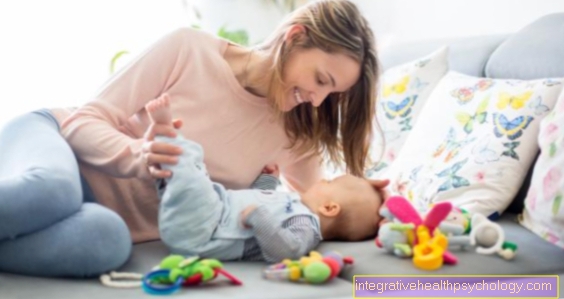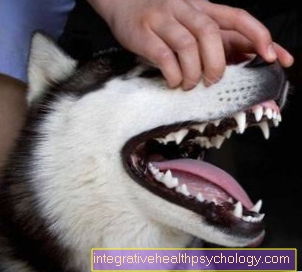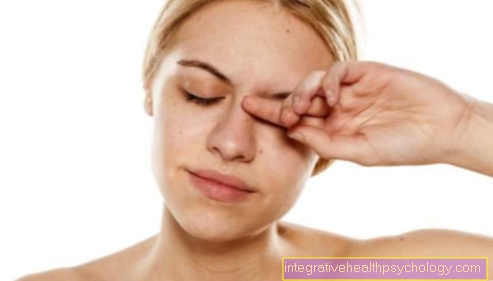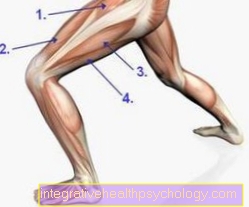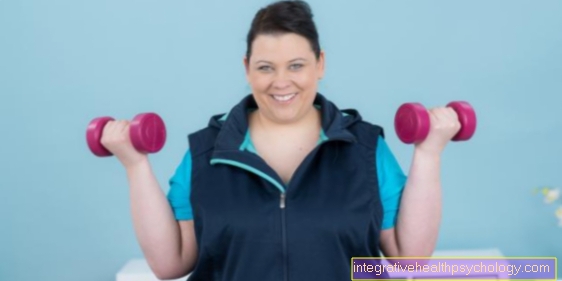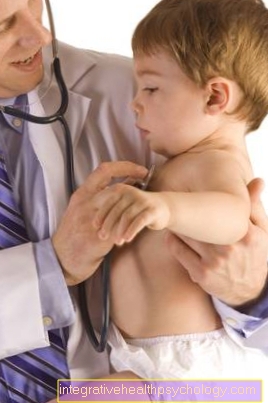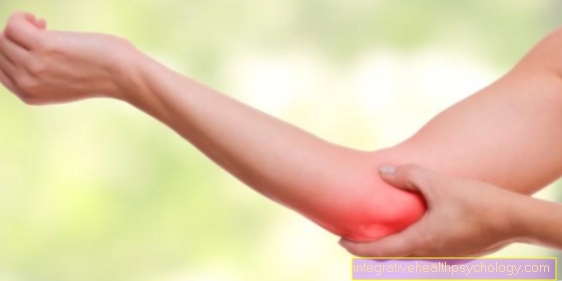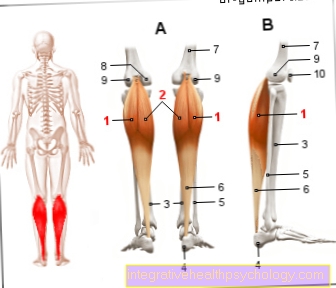Pain associated with scoliosis
introduction
Scoliosis can be associated with discomfort in some people. Above all, pain is often seen in those affected.
In addition to the back, in which the scoliosis originates, other parts of the body can also be affected. In addition to the back, there can also be abnormal sensations in different parts of the body such as the hips or legs.

Development of pain in scoliosis
In the case of scoliosis, there is also chronic incorrect loading and irregular wear on the vertebral bodies. The patient is symptom-free until the bones of the vertebral bodies finally rub against each other.
This can happen sooner or later, depending on the incorrect load on the spine. If the scoliosis is progressing or has been present for a long time, the patient initially feels pain under greater stress or after long periods of sitting or standing.
The pain is mostly localized to the side of the spine at the level where the main abnormal stresses on the spine occur. They are described as pulling or tearing.
In some cases, the pain may also radiate, mostly along the spine. In the case of very severe scoliosis or long-standing malformations, as well as conditions in which bone rubs directly on bone, patients also experience pain at rest, which can be similarly pulling.
In addition to the symptoms caused by bone friction, scoliosis almost always results in tension in the muscles that run along the side of the spine and are responsible for straightening it. These muscle tensions, which can sometimes become very hard and are also known as myogeloses, also lead to pain in the spine. One difference between the pain caused by myogelosis or by bone friction is that the former can usually be provoked by manual pressure on the muscle belly. Pain that is triggered by friction between the vertebral bodies can also be provoked, but mostly only through movement.
Movements that lead to particularly severe pain in scoliosis are bending movements in the spine, i.e. bending forward or leaning back. Also characteristic of pain that is triggered by scoliosis are discomfort when turning sideways.
In addition to the pain that is triggered by scoliosis, mechanical impairments can always occur, which are usually caused by the fact that the vertebral bodies are no longer physiologically one on top of the other and this leads to increased friction in the area of the vertebral bodies. These mechanical impairments are usually noticeable through so-called blockages. The patient can no longer perform purely mechanical movements in the spine as he is used to. It may be that he e.g. turning to the side and bending forward can only perform to a limited extent. In some cases, this blockage is also accompanied by an audible crack. The severity of the symptoms can change depending on how severe the scoliosis has progressed.
Appointment with a back specialist?

I would be happy to advise you!
Who am I?
My name is I am a specialist in orthopedics and the founder of .
Various television programs and print media report regularly about my work. On HR television you can see me every 6 weeks live on "Hallo Hessen".
But now enough is indicated ;-)
The spine is difficult to treat. On the one hand it is exposed to high mechanical loads, on the other hand it has great mobility.
The treatment of the spine (e.g. herniated disc, facet syndrome, foramen stenosis, etc.) therefore requires a lot of experience.
I focus on a wide variety of diseases of the spine.
The aim of any treatment is treatment without surgery.
Which therapy achieves the best results in the long term can only be determined after looking at all of the information (Examination, X-ray, ultrasound, MRI, etc.) be assessed.
You can find me in:
- - your orthopedic surgeon
14
Directly to the online appointment arrangement
Unfortunately, it is currently only possible to make an appointment with private health insurers. I hope for your understanding!
Further information about myself can be found at
Pain in the leg
Some people who have scoliosis experience pain in their legs. These are often found in the thighs, often together with the buttocks area. But the shin can also hurt again and again. There are various reasons for this.
One possible cause is a difference in leg length, which is either caused by a pelvic inclination due to scoliosis or exists independently of it. This creates an uneven load on the legs. This can lead to mostly unilateral leg pain. The joints are often affected because they are excessively stressed.
But it is also possible that nerves are pinched by the curvature of the spine in the context of scoliosis. These are nerves that come from the spinal cord and run up into the legs. By shifting the spine, the exit points of these nerves between the vertebral bodies can be narrowed. This leads to numbness and pain, which often get worse when you sit down. Typically, these are found in a very specific section of the leg, depending on the nerve.
To counteract this pain in the leg, depending on the cause, stretching exercises can be helpful. In addition, the legs should not be crossed when sitting to relieve them.
Thoracic spine pain
If the curvature of the spine in the thoracic spine area is pronounced in scoliosis, pain is common. The reason for this is the bony structure of the chest. Since the vertebral bodies of the thoracic spine are connected to the ribs, displacement of the spine can lead to severe pain in the chest and thoracic spine. This pain is often breath-dependent because the entire chest is moved by inhaling and exhaling. In many cases, the pain in the thoracic spine is aggravated by the muscles in the spine. In scoliosis, these are often heavily stressed and thus hardened and tense.
In addition, there are the so-called intercostal nerves. These are nerves that pull from the spinal cord in the thoracic spine and run forward along the ribs. The displacement of the spine and, as a result, the chest irritates these nerves. This can cause severe pain and is also known as intercostal neuralgia. Depending on the severity of the pain, massages, physiotherapy and pain medication can alleviate the symptoms.
Chest pain
Chest pain can also occur as part of scoliosis. It is important to distinguish whether the pain originates in the chest or radiates into the chest area. Unfortunately, it is often not that easy for those affected to pinpoint the source of the pain. Therefore, if you are unsure about safety, you should consult a doctor in order to rule out possible serious problems.
Often the chest pain is radiating pain caused by the curvature of the thoracic spine caused by scoliosis. At the same time, the so-called intercostal nerves, which pull from the spinal cord along the ribs, are pinched here. Depending on movement and breathing, this can cause severe pain.
In the case of a very pronounced form of scoliosis with a strong curvature, the pain can also arise directly from the chest. The reason for this is the pressure that is created on the organs in the chest by the displacement of the spine. As a result, the heart and lungs in particular are compressed and can no longer work properly. This leads to severe pain and should be treated by a doctor as soon as possible.
Hip pain
If you have scoliosis in the lower back, you may experience pain in the hip. The pelvis is bonyly connected to the sacrum in the area of the iliac bone. This connection is relatively strong and stiff. Shifts in the lumbar spine therefore also affect this joint connection, as the bones are pressed against one another.
Pelvic obliquity, which can cause or arise from scoliosis, can also lead to hip pain. In contrast, insoles and physiotherapy can be helpful, depending on the severity.
Muscle pain in scoliosis
Many people with scoliosis complain of pain in the muscles. The muscles in the spinal column are particularly affected. The reason for this is that the curvature of the back puts stress on the muscles for which they are not designed. This quickly leads to hardening and tension in the muscles. It is therefore very important to exercise affected muscles in order to strengthen them.
Depending on the pain and localization, there are different exercises that can be learned in physiotherapy. Massages and heat treatments can also be helpful for tension.
Impairment of organs
Since scoliosis is a misalignment of the spine, even severe scoliosis can lead to displacement and impairment of certain organs.
If organs are affected, this is very often the case lung affected. Patients with very severe scoliosis often complain of breathing problems, which result from the fact that the oblique position of the lungs prevents them from spreading as they should when they breathe in. Even if the patient stretches to reach the maximum size of the chest, they often cannot create the necessary space for the lungs in severe scoliosis.
The heart can also be affected in severe scoliosis. Nerves that lead to the heart can be compressed or irritated by the misalignment of the spine, which among other things can result in the heart beating unnaturally fast for a short time (Tachycardia).
Nerves also stretch between the ribs and supply the muscles that are part of the auxiliary breathing muscles. These muscles contract with every movement of the thorax. In severe cases, scoliosis can also compress these nerves, or so-called Intercostal neuralgia come. This means burning to shooting severe pain that can stretch around the chest and pull up to the sternum. The pain in the form of stitches usually disappears as quickly as it came, but has a strong to very strong character. It is not uncommon for those affected to feel the symptoms come from the heart.What can be added in the case of severe intercostal neuralgia is that the patient also suffers from slight shortness of breath, since inhalation in particular leads to the corresponding intensification of the symptoms.
therapy
In rare cases, back pain, myogelosis, and intercostal neuralgia all come together. It is often the case that the patients only have some of the symptoms and these do not occur permanently. An appropriate treatment strategy must then be worked out, taking into account the type and severity of the pain.
Once the cause of the pain (scoliosis) has been identified, adequate and regular anti-inflammatory pain management should be started. This usually consists of treatment with ibuprofen or diclofenac.
This should be done either with a combination of gastric protection treatment if it is a longer treatment duration or without stomach protection if a short treatment duration is indicated. The dosages range between 200 mg and 800 mg three times a day with ibuprofen and diclofenac 75 mg twice a day.
If this medication is insufficient, a stronger drug can be used. So often e.g. Tramal 100 mg for use. This medication should be taken a maximum of two times a day.
In addition to anti-inflammatory painkillers, attempts can also be made to help the patient through physiotherapeutic therapy. Physical pain treatment can also be tried. Regular, cooling treatments are used here. This is usually done with ice packs or cool packs.
Movements that lead to or even intensify the symptoms should be reduced or avoided entirely. Above all, sports that require constant rotating movements of the upper body should be avoided. Particularly noteworthy here are racket-swinging sports such as tennis, table tennis or golf. Cycling should also be avoided if possible due to the posture that is taken. However, swimming is recommended.
Read more on the topic: Treatment of scoliosis
What can you do about the pain?
Depending on the pain associated with scoliosis, there are different ways to alleviate it. It is important that the attending physician should be consulted if the pain is severe. Since scoliosis can lead to serious problems of the organs in some cases, these should be clarified before pain treatment so that they cannot go unnoticed.
Often the pain of scoliosis is caused by tense and overworked muscles.
Regular physiotherapy and various exercises can be helpful against this. The focus is on strengthening and stretching the muscles in order to adapt them to the changed load. In the case of severe tension, massages and treatments with cold or warm compresses can also be helpful.
General
Scoliosis is an S-shaped curvature of the spine, which has mostly occurred over a long period of time as a result of chronic incorrect loading. This malformation, which is also known as torsion, is usually also accompanied by a twisting of the spine. This malformation is also caused by an incorrect load. In addition to scoliosis, aggravated kyphosis (the spine curved forwards) or lordosis (the spine curved backwards) can occur. In most cases, however, scoliosis is an S-shaped side bend with torsion.
Normally, the vertebral bodies of the spine lie on top of one another in such a way that the edges of the bodies offer a certain space between the vertebral bones. The intervertebral discs are located in this space between the vertebral bodies. They serve to cushion the compressive forces that load the spine with every movement and also ensure that the movement in the spine can take place with the least possible friction.
In the course of life, there is inevitably little wear and tear on the vertebral bodies. As a rule, this proves to be a problem, especially in older patients, when the body size is slowly reducing. This is usually not associated with pain as long as the vertebral bodies wear out regularly.
Physiological and natural wear and tear in the course of life, which is completely symptom-free, presupposes that the vertebral bodies wear out evenly and that there is no incorrect posture or incorrect loading. As soon as there is an incorrect load, especially chronic, in the course of life, the protective vertebral bodies wear out irregularly.


